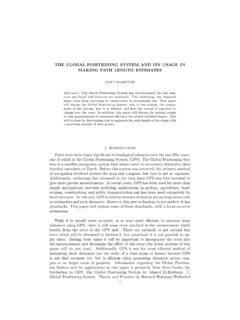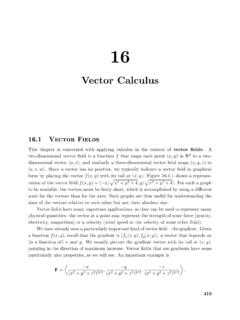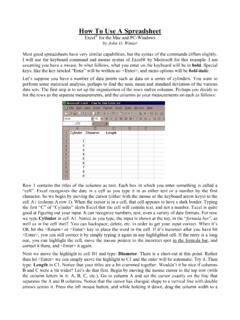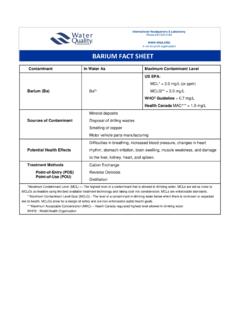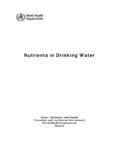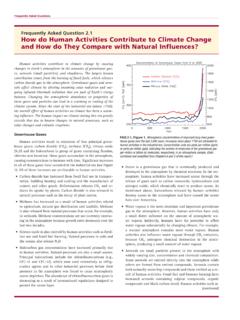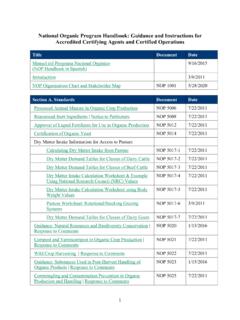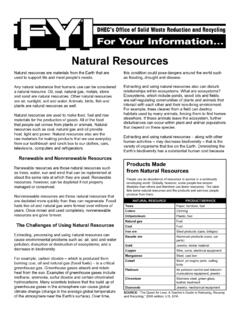Transcription of Alkalinity - Whitman College
1 Alkalinity Alkalinity is a chemical measurement of a water s ability to neutralize acids. Alkalinity is also a measure of a water s buffering capacity or its ability to resist changes in pH upon the addition of acids or bases. Alkalinity of natural waters is due primarily to the presence of weak acid salts although strong bases may also contribute ( OH-) in extreme environments. Bicarbonates represent the major form of Alkalinity in natural waters; its source being the partitioning of CO2 from the atmosphere and the weathering of carbonate minerals in rocks and soil. Other salts of weak acids, such as borate, silicates, ammonia, phosphates, and organic bases from natural organic matter, may be present in small amounts. Alkalinity , by convention, is reported as mg/L CaCO3 since most Alkalinity is derived from the weathering of carbonate minerals. Neither Alkalinity nor acidity, have any known adverse health effects.
2 Nonetheless, highly acidic and alkaline waters are considered unpalatable. Knowledge of these parameters may be important because: (1) The Alkalinity of a body of water provides information about how sensitive that water body will be to acid inputs such as acid rain. (2) Turbidity is frequently removed from drinking water by coagulation and flocculation. This process releases H+ into the water . Alkalinity must be present in excess of that destroyed by the H+ released for effective and complete coagulation to occur. (3) Hard waters are frequently softened by precipitation methods. The Alkalinity of the water must be known in order to calculate the lime (Ca(OH)2) and soda ash (Na2CO3) requirements for precipitation. (4) Alkalinity is important to control corrosion in piping systems. (5) Bicarbonate (HCO3-) and carbonate (CO32-) may complex with other elements and compounds, altering their toxicity, transport, and fate in the environment.
3 As mentioned previously, Alkalinity in natural waters is primarily due to carbonate species and the following set of chemical equilibria is established in waters where H2CO3* represents the total concentration of dissolved CO2 and H2CO3. The first chemical equation represents the equilibrium of CO2 in the atmosphere with dissolved CO2 in the water . The equilibrium constant, Henry s Law, for this reaction is The equilibrium relationships for the last two reactions may be expressed as To determine the Alkalinity , a known volume of water sample is titrated with a standard solution of strong acid to a pH value in the approximate range of 4 to 5. Titrations can distinguish between three types of Alkalinity ; carbonate, bicarbonate, and total Alkalinity . Carbonate Alkalinity is determined by titration of the water sample to the phenolphthalein indicator endpoint, or approximately a pH of Total Alkalinity is determined by titration of the water sample to the endpoint of the methyl orange indicator, or an approximate pH of The difference between the two is the bicarbonate Alkalinity .
4 Note that only approximate pH endpoints can be given. This is because the exact endpoint is dependent on the total concentration of carbonate species in solution. The higher the total Alkalinity , the lower the endpoint will be. A detailed discussion on this is given in Snoeyink and Jenkins (1980). The following endpoints, corresponding to total Alkalinity concentrations, are suggested in Standard Methods (1992): pH = for total alkalinities of about 50 mg/L, pH = for 150 mg/L, and for 500 mg/L. This lowering of the endpoint can be seen by drawing a pC-pH diagram (see the pC-pH program) for the three systems and observing the intersection of the HCO3- and H+ lines. Several points should be noted about the titration curve. (1) At pH = , the [HCO3-] equals the [OH-]. This is called an equivalence point and is the endpoint of the caustic Alkalinity and total acidity titrations.
5 (2) At pH = , the [H2CO3] equals the [CO32-]. This is the endpoint for carbonate Alkalinity and CO2 acidity titrations. In the Alkalinity titration virtually all of the CO32- has reacted (thus, the term carbonate Alkalinity ) and half of the HCO32- has reacted at the endpoint. Carbonate Alkalinity is also known as phenolphthalein Alkalinity as this is the color indicator used for the endpoint. (3) At pH = , the [H+] equals the [HCO3-]. This is the endpoint for mineral acidity and total Alkalinity titrations. References: Snoeyink, and D. Jenkins. water Chemistry, John Wiley & Sons, New York, 1980. Sawyer, and McCarty. Chemistry for Environmental Engineering (3rd Ed), McGraw-Hill Book Company, New York, 1978 Standard Methods for the Examination of water and Wastewater (18th Ed.), American water Works Association, 1992.
